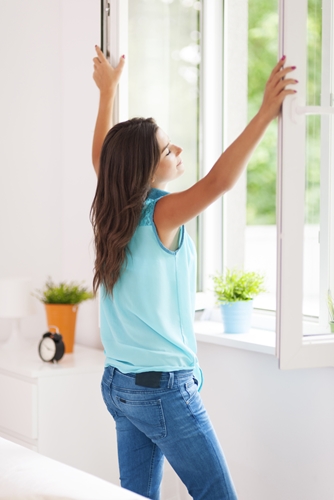
Energy efficient windows play a key role in the design of green house plans. While new-age materials and technologies are essential in the creation of those windows, homeowners may be surprised to learn that style can be just as important in achieving efficiency as polymers and fiberglass.
There are plenty of window types, from sliding to hopper to casement designs. Each of these offers a different level of energy efficiency. They also serve various functions that may be more or less desirable based on homeowners’ tastes as well as their building site. Here are just a few, as listed by the U.S. Department of Energy, and their relative advantages:
Fixed
When a window is fixed, it means that the panes don’t open. In terms of energy efficiency, they can be excellent, as they are airtight. However, they do not allow for ventilation. This design may be best served in places such as foyers to allow natural light, or as large bay windows in a living room, paired with other windows that do open. When you have a living room design such as the one depicted in this home plan, fixed panes cut down on the potential for air to leak out around such a large frame. Here a fixed pane is used as a decorative element at the top-center of the back room windows.
Sliding
The panes for this design slide horizontally, and operate exactly like the sliding doors in this design. Single-sliding has one moveable pane while double-sliding has two. The appeal of this design is that homeowners can have large windows that open and close easily. However, as the Department of Energy notes, the sliding design results in generally more air leakage than other types of windows. Side-by-side sliding windows create the opportunity for more air leaks, as the design must allow space for each pane to be able to move past one another.
Hung
Like sliding windows, hung ones have moveable panes that come as singles or doubles, though these slide vertically. Because the panes are hung vertically, they’re generally smaller than those in sliding or fixed designs. As such, they’re generally cheaper. They can also have comparably high air leakage rates. Hung windows have the added potential issue of gravity working against them, and it’s not uncommon to see the top pane of older hung windows having trouble staying up all the way. Like sliding windows, the side-by-side design adds to the potential for leakage. These windows are among the most common in homes, as demonstrated by this design.
Casement
This type of window offers generally low air leakage rates as well as nearly unparalleled air ventilation. These windows operate on hinges that allow them to swing open horizontally. According to the Department of Energy, the higher air efficiency is due to the window closing by pressing up against the frame, creating a better air seal than sliding windows. While casement windows rest on a hinge, they can still be quite sizable and are usually installed in rooms that need lots of air and light, from the bedroom to the living room. The only downside to these windows is that they can be heavy and put a lot of strain on their hinges, which may be problematic over time, but can be fixed. The front windows on the left wing of this modern house design may function like casements.
Awnings and hoppers
These kinds of windows are like casements in that they swing on a hinge, though they move vertically. Like casements, they also generally boast an excellent air seal as a result of pressing against the frame. These kinds of windows are generally smaller and used expressly for ventilation. While common in skylights, they can also be paired with large fixed windows to allow for ventilation. In the design of this contemporary house plan, the upper floor front windows seem to be operate as awnings or hoppers.